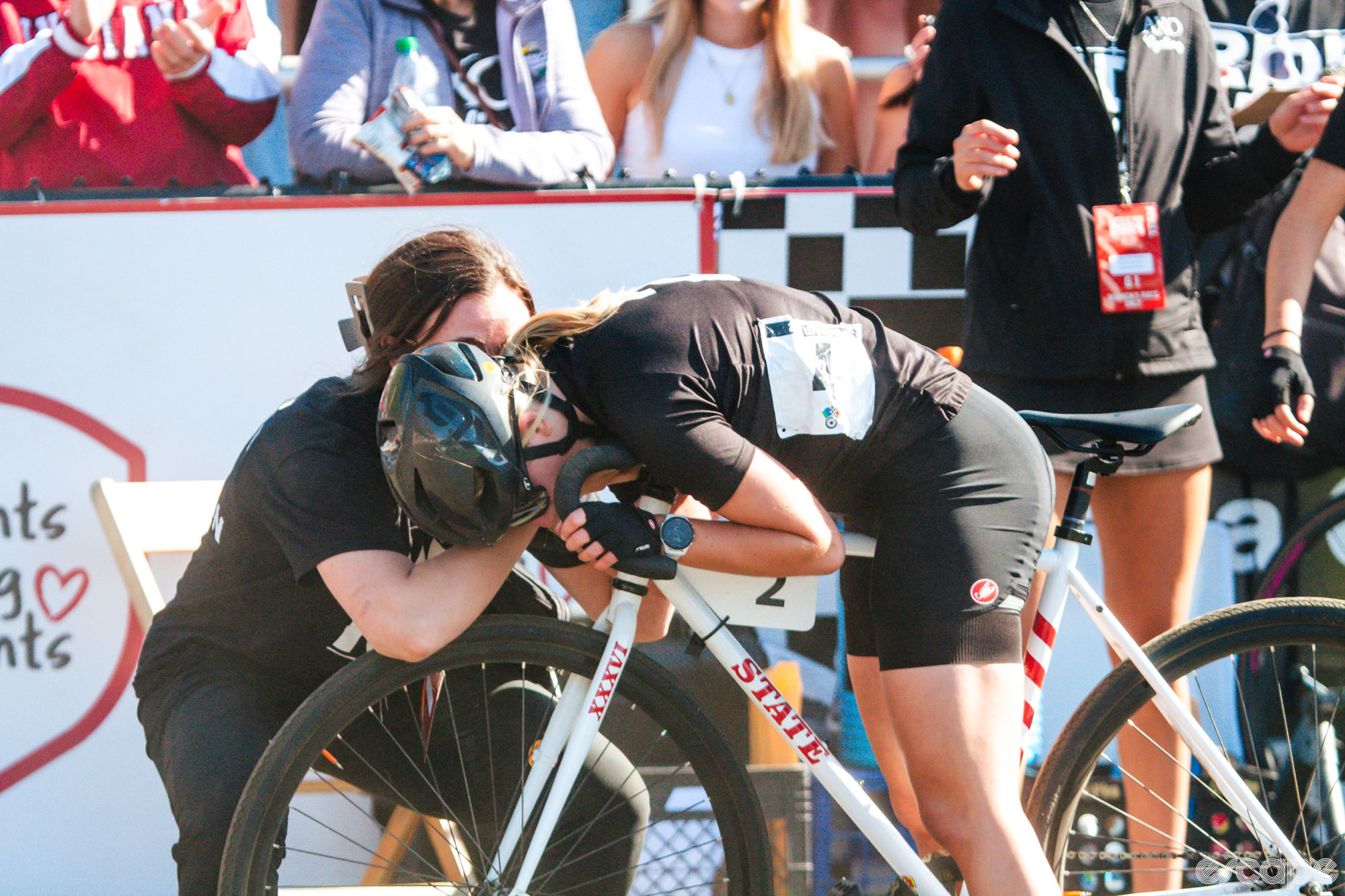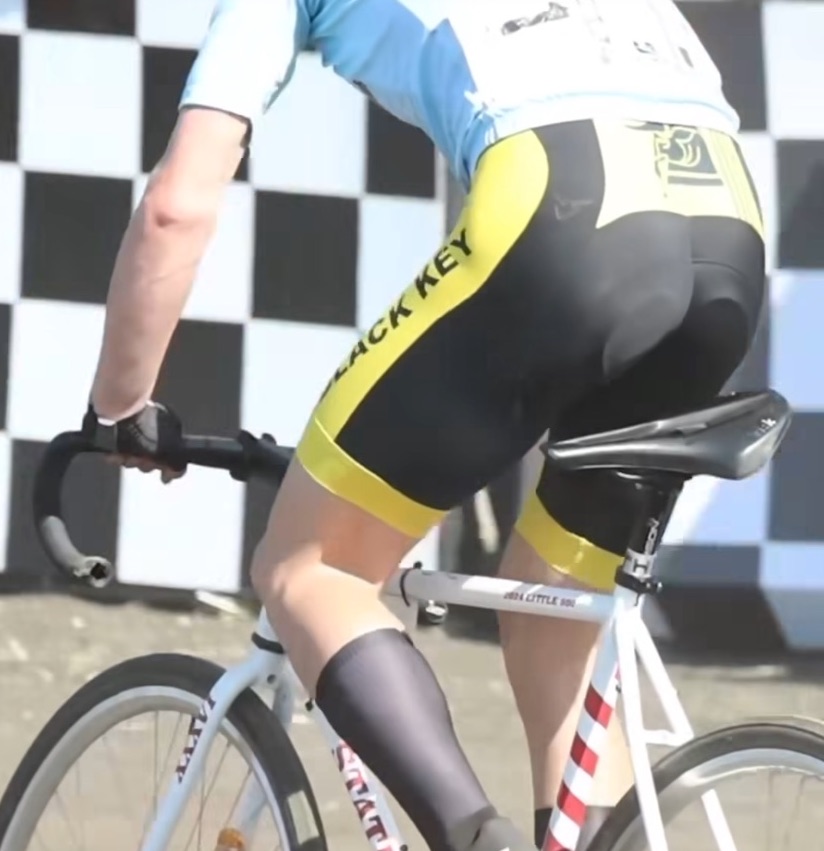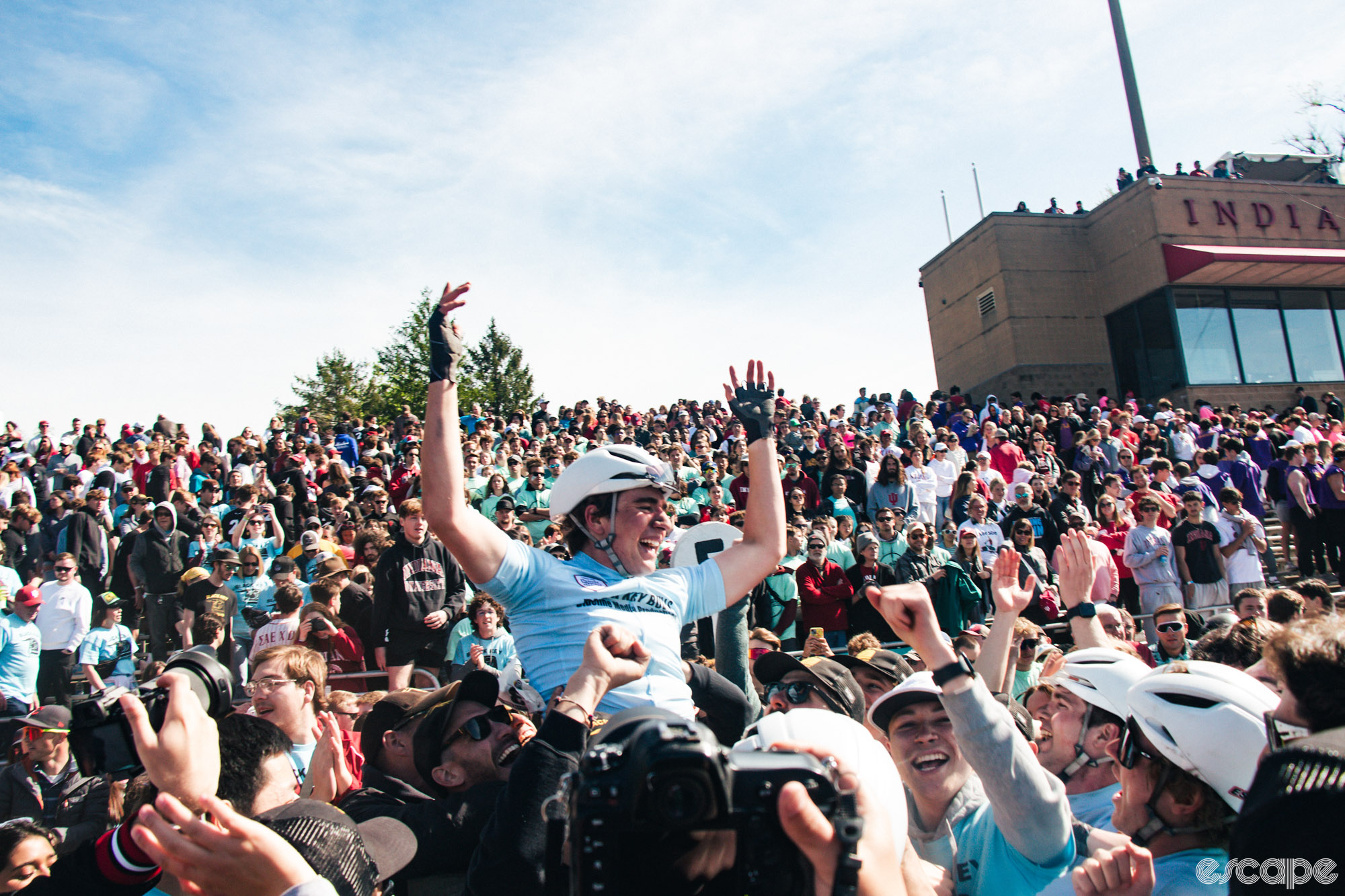“A year ago these guys were watching from the stands,” Black Key Bulls (BKB) alumnus Steven Gomez says. We’re at the edge of the 400-meter cinder track surrounded by around 15,000 fans who had traveled to Bloomington, Indiana, specifically to watch a bicycle race. It’s Little 500 day and today, a year after missing out completely, two-thirds of the way through 200 laps, the BKB boys are in the lead.
But let me step back a bit.
The Indiana University Student Foundation Little 500, a bike race that most American Midwesterners know as the week where a bunch of college kids party non-stop and the cycling-initiated known passingly as a quirk of the sport or the subject of the film Breaking Away, has been around for nearly three-quarters of a century for the men and coming up on four decades for the women. It’s a gravel race that predates the rise of gravel racing, it’s a track race that post-dates the American heyday of selling out Madison Square Garden and creating races specifically for the venue. It pulls in over 15,000 spectators in two days, making it one of the biggest bike races in America today.
The race itself is bike racing stripped down to its necessary parts: a bike from State Bicycle Co., aluminum, with no carbon fiber bits or testing in the wind tunnel, must be ridden by all teams with minimal room in the rulebook for part-swapping. Also mandated are 35 mm Kenda tires, like you’d find on any old gravel rig, but attached to a 46×18 single-speed, coaster brake drivetrain more suitable for strolling down a bike path than throwing attacks above 25 miles per hour on a track that is 400 meters long, made up of cinders so small they get stuck under your skin if you go down and so porous that the track turns into a Scottish bog under even moderate downpours.

Each team of four Indiana University students dumb, driven, and passionate enough to attempt this dangerous race are given two of these bicycles, which they must share, and told to ride around the track dozens of times (100 for the women, and 200 for the men) until the best team wins. Within these dozens of laps, the teams must each exchange – a technical rulebook requirement bolstered by the competitive reality that all four riders are guaranteed to experience the hardest day of bike racing they have ever experienced – to their fellow teammate however they see fit. The exchanges are the source of the race’s most important tactical decisions. It’s a bit like a Madison, except each team comes to a near standstill to swap riders, increasing the jeopardy.
Some teams, mechanic in tow (usually a helpful alum or friendly local bike shop whiz), choose to have a bike ready for Rider B as Rider A screams into the team’s pit, slamming on the coaster brake harder than they have since they were six years old making skid marks on their parents’ driveways. Others choose to up the danger and speed factor of the race by a degree or two, composing what can best be described as a cyclocross dismount and remount between two people. And on they go, until the best team wins.
March, 2023. The Black Key Bulls are on their third attempt of three to qualify for the 72nd edition of the Men’s Little 500. Thirty-two other teams have gotten in by successfully having their first rider complete a flying 400 with an exchange to their second rider, second to third, and third to fourth, for a total of four laps with three clean exchanges without falls, bike drops, or stepping outside of the 10-meter “exchange zone.” They are ranked by time on a big board in the middle of the track that shows a hieroglyph of Greek letters representing frats and sororities, made-up names of independent teams who aren’t affiliated with any house, dorm, or Indiana University (IU) program. And of course, the Cutters.
BKB is not yet on the board. BKB has never, in a 17-year history punctuated by two wins and at least a top-ten finish in every year of its existence, not been on the board. And yet, as two of its riders come together and step outside of the exchange zone on its final attempt to qualify for the race, BKB is out of the 2023 race. I watch this, as so many of the 40+ alumni who are flung far and wide across the country do, on my phone via a live YouTube feed in utter disbelief. Surely we get another attempt. Maybe my feed isn’t right. My eyes are just deceiving me.
My eyes do not deceive me, of course, and our alumni group chat explodes to life with the disbelief, anger, and hopelessness that tracks more closely with the rapid response to a national tragedy than to a bunch of past-their-prime college grads watching four 18-22 year-olds sling themselves around a gravel track on an otherwise beautiful Spring day in Bloomington. That’s that. There will be no Little 500 for BKB this year.
April 20, 2024. Lap 150 of 200. BKB qualified this time around, in the third position behind Sigma Phi Epsilon (“Sig Ep”) and Sigma Alpha Epsilon (“SAE”). I find myself on the fence behind the pit, where BKB’s four riders, all first-time racers, sit on old resistance trainers passed down from generations before, spinning their legs ostensibly to warm up but more realistically out of nervous habit, giving their anxious brains something to focus on instead of the 10-20 lap efforts, taking around 8-15 minutes, they’ve been putting themselves through multiple times today.
SAE have been off the front for an unheard-of number of laps so far today – something like 100 of them at this point, mostly alone, and the discussion between Coach Jordan Bailey and Coach Emeritus Ryan Knapp on the threat of SAE’s lead (at or about 200m meters for the last hour, which has felt like a decade) has vacillated between “this is just a French pro conti team getting TV time in the Tour” and “this is ten strong dudes with a five-min lead with 10k to go,” to put the varying levels of concern into road racing terms. Although SAE’s move started as a solo flyer off the back of a “burn,” a 20-second sprint off the front of a pack used to build a gap that helps smooth the exchange, the effort has tossed lesser teams aside and has turned into more of a chase between two breakaways. There is hardly a peloton.
We glance to the side. SAE riders look less fresh on the trainer, a bit more antsy to come in and get out of the race, and are showing signs of fatigue most any Little 500 racer would recognize: shorter sets, dogged eyes, sloppy exchanges. The gap has come down from its maximum of 28 seconds (a lifetime on a single gear when lapping the field means getting about 35-40 seconds ahead) to around eight.
“Now?” Bailey looks at Knapp, sensing that its chase group is about to blow apart. Nobody wants to turn the race into an individual pursuit with so many laps still to go.
“I think now is good,” Knapp responds to Bailey. Bailey goes to his trusty pit board, a small dry-erase board he picked up just this morning at a local office supply store, and pins a picture of Vin Diesel’s face to it for the senior on the bike, Jack Handlos, to see as a signal: Fast and Furious. Handlos, whose arms are built more akin to a pro wrestler’s than a cyclist’s, guns it on the bike, pulling back SAE while blowing up his own chase group in the process.
“We sort of wanted that to stay together,” Knapp mentions.
“So be it,” Bailey glances over. If these other teams can’t hold onto the move, they’re not much use to us, anyway, he thinks.

This move tires out Handlos as much as it does the rest of the field, and it’s time for everyone to exchange. Even at the best of times during the race, exchanging is chaotic: for a few seconds, the incoming rider has no choice but to stand in the middle of the track, bike in hand and arm outstretched to receive the tag to go in while 30 others teams rush by in a fight for their own lives. This particular exchange has the added difficulty of SAE, Sig Ep, and another fraternity near the lead – Chi Alpha – all exchanging alongside BKB (because exchanges are such a vulnerable time for any team, teams often try to key off each other to soften the blow of having to remake a pack over and over again).
But Handlos nails it and switches Will Wagner, a junior from suburban Illinois, onto the bike.
This is the move.
The alumni crowded on the fence all slap Handlos on the back. He knows, and they know, that the first race – the race to catch the SAE Carrot – is done. Now it’s time to win the bike race.
After an hour dangling off the front, SAE demands the front again in what is now a five-person lead pack within which the race winner can almost certainly be found. They aren’t done making this race the hardest Little 500 I’ve ever witnessed just yet. Paradoxically, this race – a pure team event in every sense of the word and much more so than the typical road race or Grand Tour where we say a team won, but in reality know an individual won – leaves each rider alone out on the track, with their three teammates stuck hoping for the best until it’s their turn to catch back on. Therefore, any and every move in the race is calculated among the horsetrading that your rival on lap 50 could become your closest ally on lap 120, only to be the team you’re sprinting against on lap 200.
SAE, led by Luke Naas, the winner of the Individual Time Trial that occurred earlier in the year, are gassed, but perseverant. Sig Ep, the pole winner and winner of the Spring Series, a three-race event that consists of races familiar to the average track racing fan – ITTs, Team Pursuit, and Miss n’ Out – have chosen to let bike racing happen to them. Perennial powerhouses Cutters and Delta Tau Delta have been present and generally cooperative, but unreliable. This leads the BKB pit to quickly realize the most-likely outcome for the day: with SAE completely burned out and the other teams waffling between fatigue and indecision, BKB can win this just over a year after it failed to make it into the field at all. But it’s going to take 50 laps, or about 30 minutes, of the hardest riding these four guys have likely ever done.
“Luke Naas was fucking chasing me?” McGuire Wolfe, a senior, says in disbelief as he gets back to his trainer and starts spinning again after a three lap set ending at lap 165. Wolfe is a very good Little 500 rider, with a 24th place at ITTs and a second in Team Pursuit to boast. But he knows, and the data provides, Naas is faster. But Wolfe is having the sort of day all bike racers dream of and only few experience: on the day that matters most, on his equivalent of Paris-Roubaix or a trip down the Champs, Wolfe has nearly unlimited fitness. The sensations are good, as a Euro pro might say. Earlier in the race, after his first set of 14 laps from the first quarter of the race, when SAE’s original move was starting to kick off and teams behind were organizing, he looked at me and asked if every set was that hard. “That one was particularly hard,” I assured him, “especially for a first set. But this pace will back off later.”
I had lied to him. That pace had failed to back off, and now, an hour later, we were entering that point in an already brutal day where the race is won and lost. Bailey, screaming over the chants of the fraternities pitted next to BKB, told the guys the same: the race is there for you to take it, and you are in the best position to win this. But you have to ride to hell and back to do it.
What I witnessed over the next 30 or so laps was something any bike racing fan immediately recognizes as a predestined result of riders on their absolute best day: a rider – or in this case, a team of them – who are either going to win the race or die trying. The feeling one gets when Mathieu Van der Poel makes his way to the front ahead of the Koppenberg or, in Tours de France gone by when Cav has his train organized. As BKB swapped in and out of sets, all four of the guys were of a single mind. Sometimes they would find themselves in a pack of a few riders to work with. Sometimes they wouldn’t. It didn’t matter – no one else was on that track in their minds at that point.
By lap 180 the race was completely blown apart. Although I could count up to five teams on the lead lap, a combination of divergent exchange schedules and shattered legs kept no more than two or three teams together at any one time, if at all. Having done all he could for about eight laps, Handlos came in for an exchange to Wagner, which got off cleanly, but baseball slid into the pit. Sig Ep, attempting to exchange just behind, were unable to redirect their rider out of the fray. That incoming rider smashed into Handlos with such force (as you can imagine from a college boy having just done one of the hardest efforts of his life) that Handlos was unable to continue with the race. The team, who looked in prime position to fire-drill to the finish, was now down its senior captain for the remaining 20 laps.
No matter. Despite the crash taking out Handlos, Wagner, Wolfe, and freshman Wiley Close were able to stay off the front for the remainder of the race with a combination of eye-bleeding, quad-breaking two to five laps sets – one of which found Close, around lap 194, riding a bike without a functional seat post after the bolt holding the seat clamp stripped completely out.

By 198, Wagner had a clear gap that he could ride to the finish, but with chase behind that had now organized itself, teams were closing rapidly. The end-game had all the drama of a successful solo breakaway, charging teams looking to spoil the Cinderella story included. The PA announcer, clearly not informed of how quickly these things can come together in moments like this, mentioned to the crowd that a heated battle for second place was taking place. Fearing the announcer kiss-of-death, an unwritten rule that you never mention a perfect game or penalty save percentage, the BKB pit and the hundreds of fans behind echoed a mix of gasping and laughing.
The rest of the stadium knew what they had yet to grasp: BKB had done it.
Wagner finished lap 200 with enough time to pump his fists and give a bow to the crowd. As BKB’s fans rushed onto the track to lift their heroes in the air and find someone to hug, Steven Gomez found me and motioned back to the stands. Spectators no more.
The morning after the race, in the afterglow of his first victory, Coach Bailey had again just become Jordan to me, one of my closest friends and most important mentors and was graciously dropping me at the airport on his way home. As we sat at a stoplight on the way there, I mentioned to him that while watching Liège that morning, the commentators discussed that Pogačar had done exactly what he said he was going to do – attack over La Redoute. I mentioned to him how I admired when riders reached this point, where they could say exactly what their plan was and didn’t have to resort to fooling people or coming up with some convoluted race day nonsense of a plan.
“So I guess we just do that same thing again next year, huh?” He said back to me, clearly catching onto the parallels I was trying to draw.
“Hope those boys are fit.”
Nicholas Hartman is an Indiana University and Black Key Bulls alum, former Little 500 racer, and current lawyer. He thinks you should go to Bloomington, Indiana next spring for the biggest little bike race on the planet. You can watch both the women’s and men’s 2024 races on YouTube.
What did you think of this story?

